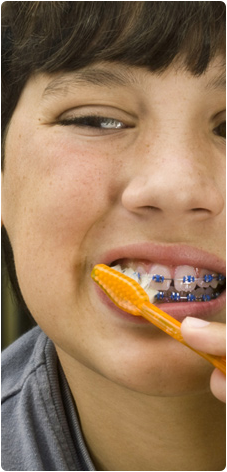
Oral Hygiene With Braces
Keeping a Healthy Smile
Braces create small ledges, nooks and crannies for food deposits, which can lead to cavities and gum problems. This makes brushing and flossing even more important while you are wearing braces. When you brush and floss, handle your appliances carefully so you won’t break or loosen them. Following these brushing and eating tips will keep your appliances and smile healthy.
Brushing
Be sure to brush your teeth right after every meal and before you go to bed. It’s best to use a fluoride toothpaste to help fight cavities. Use a soft toothbrush and brush at a 45-degree angle to the tooth in small circles above and below the brackets, as well as all the other surfaces of your teeth. Since it is harder to keep your teeth clean with braces, every time you clean them you will need to brush your teeth for at least 2 minutes. Your toothbrush will wear out faster because of your appliances, so be sure to replace it whenever the bristles start to fray.
Flossing
Because your toothbrush won’t reach between your teeth, brushing alone won’t keep your teeth clean and healthy. Flossing can help. A floss threader helps you floss with braces on. Floss 1-2 times a day like this:
- Thread the floss through the threader and slip it behind your archwire.
- Pull the threader with the floss between two teeth, and then floss the teeth. Be sure to floss under your gum margins.
- Rinse your mouth with water.
A Waterpik can be a useful addition, but it cannot completely remove the sticky plaque that adheres to the teeth. If you are having trouble cleaning your teeth properly with a manual toothbrush, an electric toothbrush may be beneficial.
Remember
You should be brushing at least 3 times a day - after breakfast, after lunch and before you go to bed. It is much better to do a great job brushing 3 times per day than a poor job 10 times a day. If you are not able to brush after you eat, be sure to rinse your mouth thoroughly with water. NEVER skip brushing and flossing at night before you go to bed.
Last but not least, see your dentist for a professional cleaning on a regular 3-6 month basis. Your dentist and hygienist can do a thorough job cleaning your teeth, help detect problem areas, and offer tips/tools for improved hygiene. Please remember, however, there is nothing the dentist can do that will overcome what the patient will not do. Prevention of dental decalcification and decay rests with the patient.
Decalcification
Decalcification of teeth, also known as "white spots," consists of PERMANENT white discolorations of the tooth surface. Decalcification is usually caused by inadequate oral hygiene and/or improper diet during some part of your orthodontic treatment. As a result of inadequate oral hygiene and/or improper diet, plaque accumulates around the braces and the acid released from the plaque can lead to decalcifications. If these "white spots" occur during treatment and the patient’s oral hygiene and/or diet is not improved, they may progress to tooth decay. Even though several options are available to improve or mask the presence of decalcifications, we believe that preventing their development from the outset of treatment through excellent oral hygiene and proper diet is as important as achieving straight teeth - if not more important!
















NEWNAN GA 30263